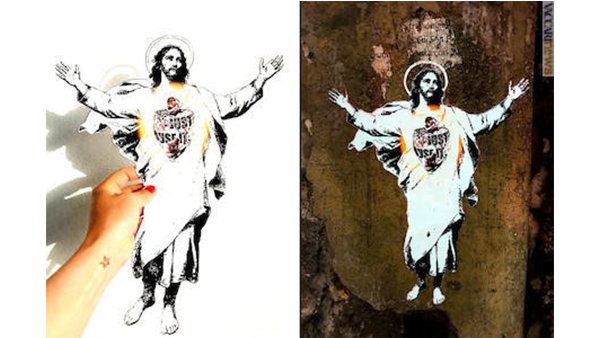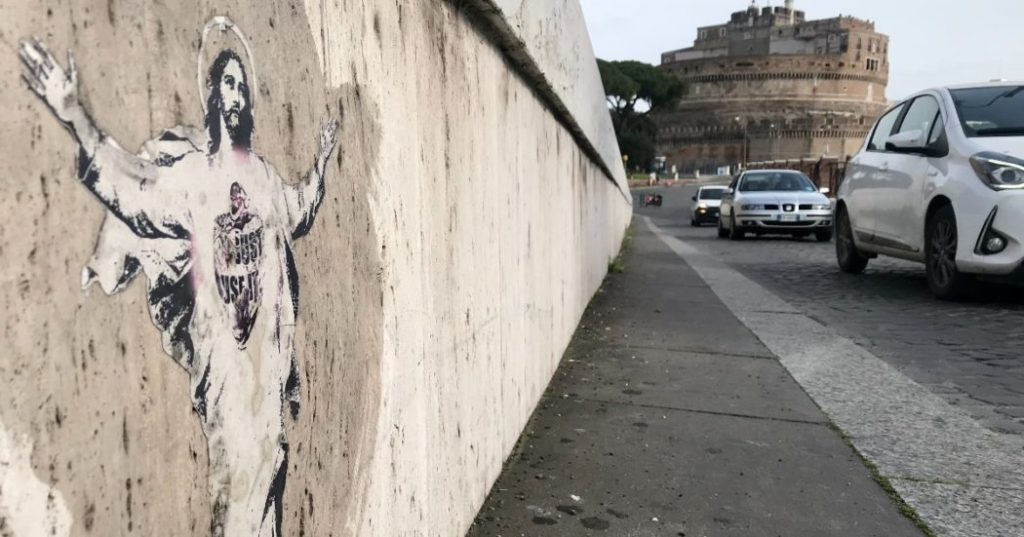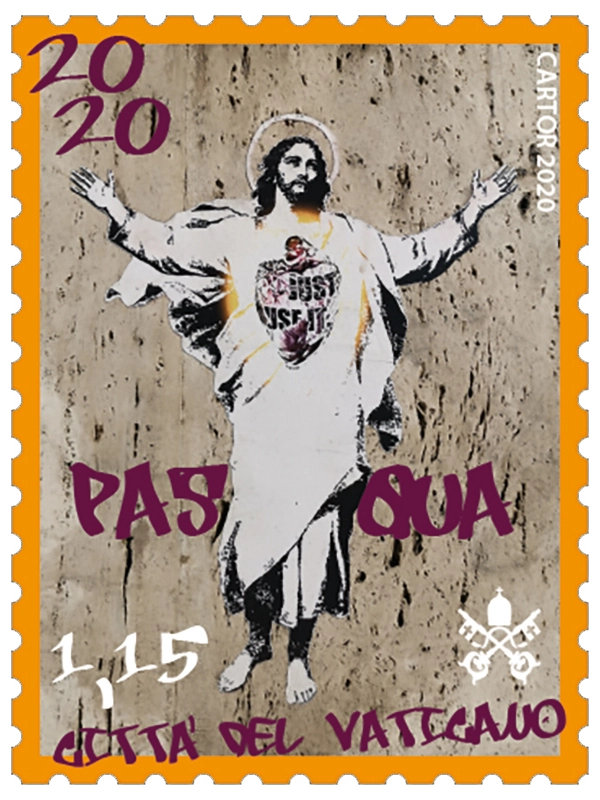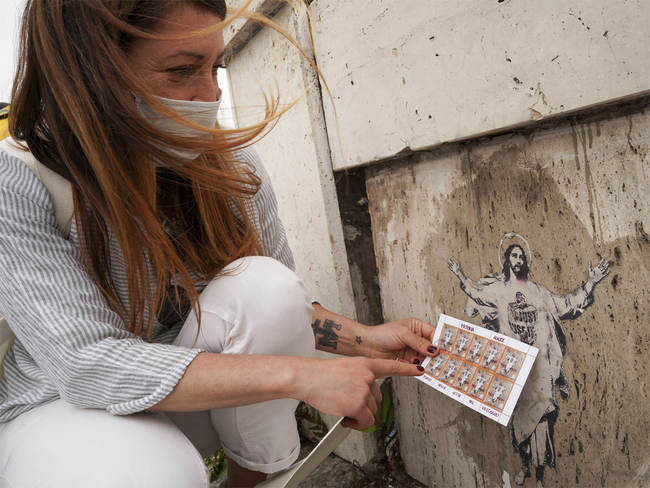Holy infringement: an artist dares to sue the Pope
Alessia Babrow’s hand with the poster and one of the street art representations
You might have heard about a recent IP case going on in Italian Courts which sees a young street artist opposing the Vatican Philatelic Office. But what is the Vatican Philatelic Office?
Well, let’s start from the beginning.
Vatican City, officially the Vatican City State, is an independent city state and enclave located within Rome, Italy. Known also as simply the Vatican, it’s the official residence of the Pope, head of the Catholic Christian Church.
Since 1940, the Vatican has had its very own Philatelic and Numismatic Office, in charge of designing and selling exclusively-made stamps and coins produced annually for the smallest State in the world, the Holy See.
So, what happened between the artist and the Vatican? It all started one night, when the director of the Vatican Philatelic Office, wandering around in Rome took a picture of an image on a wall and decided to use it for a new stamp the Vatican issued to celebrate the coming Easter.
That image was actually a poster art, meaning a printed image glued on the wall, made by the Italian artist Alessia Babrow. The artist reinterpreted the image of Jesus Christ as it appears in the “Ascension” by Heinrich Hofmann, a German painter who lived between 1824 and 1911. She applied a big heart in the middle of the figure, with the motto “JUST USE IT”. You can see the same representation in many places in Rome.
Photo by Alessia Babrow
We appreciate the choice made by the Vatican to rejuvenate the style of their stamps, previous emissions were quite classic (“the Renaissance and friends”).
And it surprised the artist, who thought it was a joke when she discovered it, after the postage stamp went to the market, in 8.000 pieces sold for 1.40 euro each.
But the papal endorsement was not enough for the artist to be flattered, nor was the Vatican's proposal to close the case with some free stamps and a private meeting with the Pope. The artist refused both, and decided to sue the Vatican, after more than one year of unsuccessful attempts to see the authorship of her work recognized.
With a lawsuit started in a Roman court in April this year, the artist accuses the Vatican City State’s telecommunications office of wrongfully profiting off her creativity and violating the original intent of her artwork, and asks for a 130,000 Euro compensation.
|
|
The issue brings forefront the matter of copyright in the field of street art and public art. Street art, as a manifestation of figurative art, according to Italian law, enjoys the protection of copyright and the author has both the moral right, concerning the protection of the personality, and the patrimonial rights, concerning the use of the work created. Exclusive rights of use and economic exploitation of the work in all its forms and ways, including the right to reproduction, publication, distribution and sale. It should be noted though, that the application of the copyright law to street art is still sometimes unclear, and the interpretation of the protection of moral rights rises some controversies. The nature of street art (in all its forms, such as poster art, graffiti, tags, stencil, sculpture, etc.) is to be visible, free, part of the urban space, which is public. We can add that, being subject to the weather, it’s perishable per se: the artist should take into account that his/her work can be destroyed. |
Furthermore, the fact that street art is done on surfaces that have a property (which can be public or private), implies that the owner of the surface could decide to remove the surface, or modify it, basically without the consent of the artist (who remains, in most cases, anonymous or known by pseudonym due to the illegality connected to this activity).
And here a question rises spontaneously: if street art is aimed at everyone and lives illegally, then who does it belong to? Street art is also "free" from the dictates of art: it has no rules, it is the highest expression and is not located in museums or galleries. Its stage is the street where everyone can see it, love it and, why not, modify it or hide it forever.
Street artists are usually also less prone to defend their work from the copy made by other street artists: often they pay homage to each other, or just take inspiration, and in this case the copyright can be a limitation of the creativity.
Nevertheless, we must make a distinction between street artwork and the rights of reproduction and utilization of that artwork.
“Many street artists sell their merchandise through authorized galleries and shops, or even have production of artworks dedicated to a gallery and an auction circuit. […] But products associated with these trading activities are not street art. How copyright deals with those objects has to do with how such rights regulate and influence commercial practices” (A. Baldini, A philosophy guide to street art and the law, 2018).
Alessia Babrow compares the Vatican's stamps with her street artwork
Since early years of 2000 street art is becoming a celebrated feature of every city. In fact, street art became so acclaimed that it is being not only allowed but also commissioned as part of interior or exterior design of restaurants, retail stores, etc.
There are numerous and increasing public initiatives or initiatives promoted in public-private partnerships, which support and finance urban art interventions. Furthermore, through street art it is possible to reconfigure the perception of the urban context, making it an aesthetically pleasing place, worthy of attention and protection.
I don’t want here to deal with the nature of street art as subversive expression associated with illegal activities, and with a message often rebellious that is of course diluted, if not cancelled, by this process.
What’s interesting here is that while the appropriation of street artwork is becoming a quite common practice, even with commercial intent, thanks to the legitimacy of this kind of artistic practice many street artists fight to protect their works and sue companies and Popes for unauthorized use of street art.
The case of the postage stamp made by the Vatican falls under this specimen: the unauthorized commercial use of a copyrighted work. We can make a hypothesis on how it will go… except a divine intervention we can easily forecast the verdict given these premises.
We’ll follow the case and keep you …posted.






